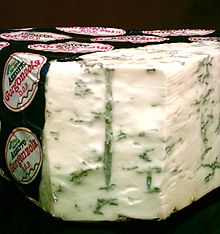
Tartaric acid is a white, crystalline organic acid that occurs naturally in many fruits, most notably in grapes, but also in bananas, tamarinds, and citrus. Its salt, potassium bitartrate, commonly known as cream of tartar, develops naturally in the process of fermentation. It is commonly mixed with sodium bicarbonate and is sold as baking powder used as a leavening agent in food preparation. The acid itself is added to foods as an antioxidant E334 and to impart its distinctive sour taste.

Penicillium is a genus of ascomycetous fungi that is of major importance in the natural environment, in food spoilage, and in food and drug production.

Roquefort is a sheep milk cheese from Southern France, and is one of the world's best known blue cheeses. Though similar cheeses are produced elsewhere, EU law dictates that only those cheeses aged in the natural Combalou caves of Roquefort-sur-Soulzon may bear the name Roquefort, as it is a recognised geographical indication, or has a protected designation of origin.

Stilton is an English cheese, produced in two varieties: Blue, which has had Penicillium roqueforti added to generate a characteristic smell and taste, and White, which has not. Both have been granted the status of a protected designation of origin (PDO) by the European Commission, requiring that only such cheese produced in the three counties of Derbyshire, Leicestershire and Nottinghamshire may be called "Stilton". The cheese takes its name from the village of Stilton, now in Cambridgeshire, where it has long been sold.

Gorgonzola is a veined blue cheese, originally from Italy, made from unskimmed cow's milk. It can be buttery or firm, crumbly and quite salty, with a "bite" from its blue veining.

Ernest Duchesne was a French physician who noted that certain molds kill bacteria. He made this discovery 32 years before Alexander Fleming discovered the antibiotic properties of penicillin, a substance derived from those molds, but his research went unnoticed.

Blue cheese or bleu cheese is cheese made with cultures of the mold Penicillium, giving it spots or veins of the mold throughout the cheese, which can vary in color through various shades of blue and green. This carries a distinct smell, either from that or various specially cultivated bacteria. Some blue cheeses are injected with spores before the curds form, and others have spores mixed in with the curds after they form. Blue cheeses are typically aged in a temperature-controlled environment such as a cave. Blue cheese can be eaten by itself or can be spread, crumbled or melted into or over a range of other foods. Blue cheese is known for its pungent creamy texture.
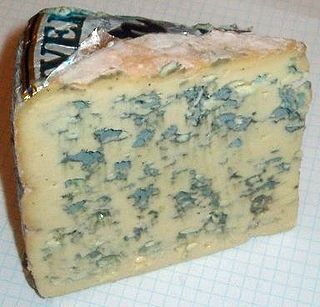
Bleu d'Auvergne is a French blue cheese, named for its place of origin in the Auvergne region of south-central France. It is made from cow's milk, and is one of the cheeses granted the Appellation d'origine contrôlée from the French government.

Penicillium roqueforti is a common saprotrophic fungus in the genus Penicillium. Widespread in nature, it can be isolated from soil, decaying organic matter, and plants.
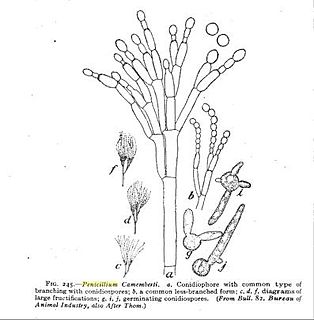
Penicillium camemberti is a species of fungus in the genus Penicillium. It is used in the production of Camembert, Brie, Langres, Coulommiers, and Cambozola cheeses, on which colonies of P. camemberti form a hard, white crust. It is responsible for giving these cheeses their distinctive flavors. An allergy to the antibiotic penicillin does not necessarily imply an allergy to cheeses made using P. camemberti.

Bleu de Bresse is a blue cheese that was first made in the Bresse area of France following World War II. Made from whole milk, it has a firm, edible coating which is characteristically white in color and has an aroma of mushrooms. Its creamy interior, similar in texture to Brie, contains patches of blue mold. It is shaped into cylindrical rounds weighing from 125 to 500 grams.

The history of penicillin follows a number of observations and discoveries of apparent evidence of antibiotic activity of the mould Penicillium. Following the identification of Penicillium rubens as the source of the compound in 1928 and with the production of pure compound in 1942, penicillin became the first naturally derived antibiotic. There are anecdotes about ancient societies using moulds to treat infections, and in the following centuries many people observed the inhibition of bacterial growth by various moulds. However, it is unknown if the species involved were Penicillium species or if the antimicrobial substances produced were penicillin.

Bleu des Causses is a French blue cheese made from cow's milk. It is considered a mild variant of Roquefort. The cheese has a fat content of 45% and is aged for 3–6 months in Gorges du Tarn's natural limestone caves. The ripening process involving naturally temperature-controlled cellars is the major element that gives it its special aroma.

Bleu de Gex is a creamy, semi-soft blue cheese made from unpasteurized milk in the Jura region of France.
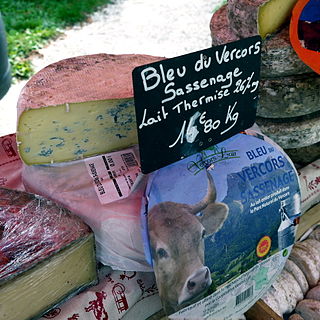
Bleu du Vercors-Sassenage is a mild pasteurized natural rind cow's milk blue cheese originally produced by monks in the Rhône-Alpes region of France in the 14th century. Now made in the Dauphiné area, the cheese has been a protected Appellation d'Origine Contrôlée since 1998. As a requirement, the cheese has to be composed of milk from Montbéliard, Abondance or Villard cows. The cheese is unpressed and uncooked and contains the mold Penicillium roqueforti. In Larousse's Grand Dictionnaire Universel of the 19th century, King Francis I is described as being quite fond of the cheese.
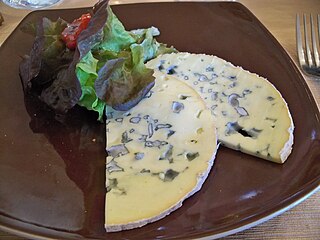
Fourme d'Ambert is a semi-hard French blue cheese. One of France's oldest cheeses, it dates from as far back as Roman times. It is made from raw cow's milk from the Auvergne region of France, with a distinct, narrow cylindrical shape.

Cheese is a dairy product, derived from milk and produced in wide ranges of flavors, textures and forms by coagulation of the milk protein casein. It comprises proteins and fat from milk, usually the milk of cows, buffalo, goats, or sheep. During production, the milk is usually acidified and the enzymes of rennet are added to cause the milk proteins (casein) to coagulate. The solids (curd) are separated from the liquid (whey) and pressed into final form. Some cheeses have aromatic molds on the rind, the outer layer, or throughout. Most cheeses melt at cooking temperature.

Fourme de Montbrison is a cow's-milk cheese made in the regions of Rhône-Alpes and Auvergne in southern France. It derives its name from the town of Montbrison in the Loire department.

Types of cheese are grouped or classified according to criteria such as length of fermentation, texture, methods of production, fat content, animal milk, and country or region of origin. The method most commonly and traditionally used is based on moisture content, which is then further narrowed down by fat content and curing or ripening methods. The criteria may either be used singly or in combination, with no single method being universally used.
